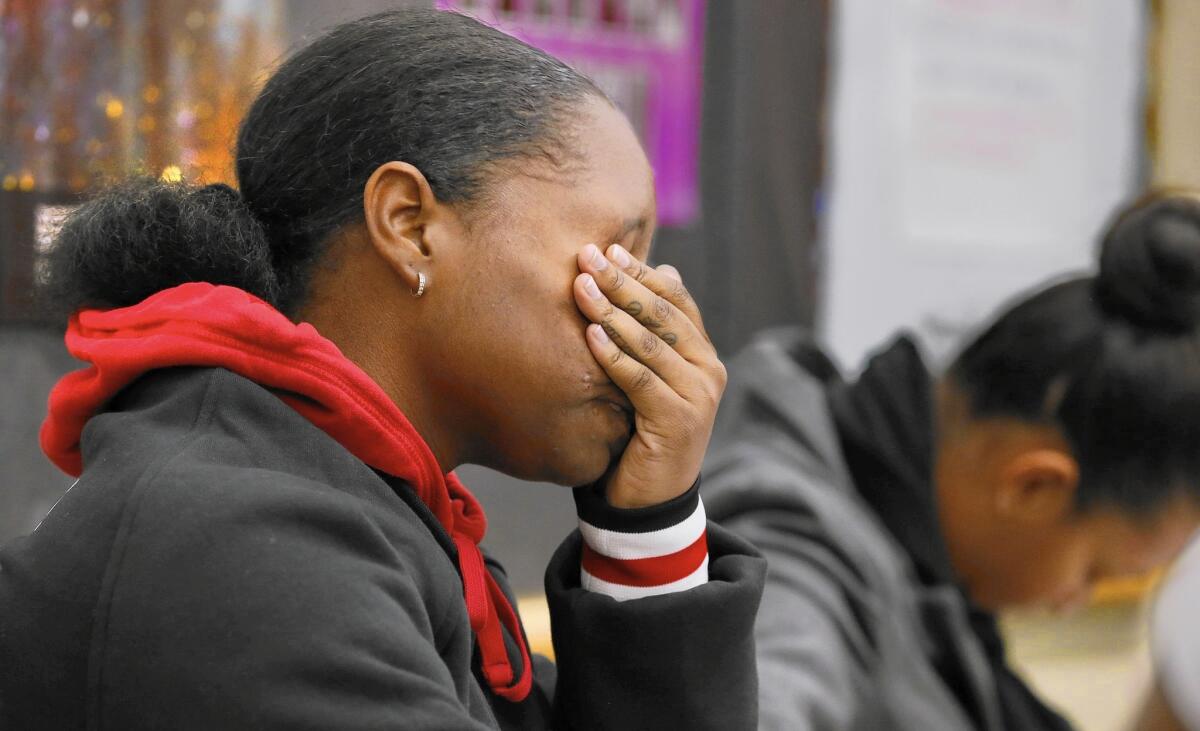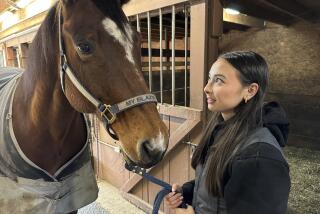Column: How some teens learn to sustain hope ‘when times are hard’

Students take part in an emotional discussion about the fate of a onetime Westchester high school student who was recently shot and paralyzed.
When English teacher Johanna Bernstein assigned her students at Westchester High to read my column about a young man who’d been paralyzed in a shooting, she envisioned a lesson on vocabulary and composition:
Charismatic. Embody. Plight. Rap sheet. Why did the writer choose those words? What do they mean? How does the column employ ethos, pathos and logos?
Bernstein had no idea that the subject of that column, Semaj Clark, 18, once had attended Westchester. “A pall fell over my students when they realized that this terrible fate had struck someone they knew,” the teacher told me last week.
Clark had been an unmanageable kid and irregular student until he enrolled in a mentoring program that helped turn his life around. He was in Savannah, Ga., last month to address a public safety forum when he was shot in the back as he tried to flee a robbery attempt. A 17-year-old has been charged in the attack.
Bernstein said “students were mesmerized” as they silently read and annotated the column in class. Only then did she learn that several had known Clark as a classmate or a friend.
“To see his story in the newspaper caused them to sit up straight and pay attention in a new way,” she said.
I visited Bernstein’s students on Wednesday. I wanted to understand what Clark’s tragedy meant to them.
::
Bernstein reminds me of English teachers I had in Cleveland 40 years ago, at a high school very much like Westchester. She has been teaching for 41 years. She expects all of her students to go to college.
“I push them hard,” she told me. “And they push back.”
Most are bright, thoughtful and hard-working, but many have gaps in their education or lack support outside of school. “I have students,” she said, “who were amazed when I told them that in textbook English, we don’t say: ‘I seen that fight at lunch.’ ”
The campus, now called Westchester Enriched Sciences Magnets, sits in the shadow of LAX and draws students from both middle-class and low-income areas of West and South Los Angeles. It has the most black pupils of any high school in Los Angeles.
Clark attended Westchester three years ago, then transferred to an alternative program for students at risk of dropping out. His classmates, now seniors, remember a quiet young man who spent his smarts on hustling instead of homework.
They hadn’t known about Clark’s tough life: born to a teenage addict, never knew his father, abused in foster care.
They understand his choices better now.
I wanted to know what guides their choices. Why do some kids stay on track and others fall off?
They agreed on the essentials: strong families, safe neighborhoods, a relationship with God. Then they talked, with confessional candor, about the details of their lives.
The public airing of Clark’s struggles seemed to free them to talk about theirs. Some shared stories so intimate and raw, Bernstein spent the period passing around a tissue box.
I never would have guessed that the quiet girl whose torturous words spilled out like poetry had skipped school and sold drugs to keep her family afloat. Her mother is a domestic violence victim who can’t shake her abuser.
For the 17-year-old, life is a spiral of arguments and evictions — a daily battle against the scourge of hopelessness. She wants to go to college, “but I just have to go day by day,” she said.
Their stories — conveyed without a hint of self-pity or complaint — made me realize how much courage adolescence can require. These are young people carrying grown-up problems on a tightrope walk through trouble.
We don’t celebrate, or even recognize, their resilience nearly enough.
::
I was surprised as I listened by how often a single force had made a significant difference: the example of a hard-working single mother, the vigilance of a sibling, the police raid on a drug dealer’s house that made a teen commit to college “so I can get a job that pays enough money that I don’t have to raise my kids in a neighborhood like mine.”
Kaelyn’s streetwise older brother was flirting with trouble. His salvation was a football scholarship to San Jose State. “If he didn’t have that, and a praying family, he’d be a statistic,” she said.
Johnathan’s two older brothers belong to gangs. “Mostly everybody in my family bangs,” he said. Except his older sister, who watches him like a hawk to keep him safe.
For De’jah, the force was Semaj Clark.
She came to me after class and fought back tears as she talked. When he was in 10th grade and she was a freshman, “Semaj was doing bad things,” she said. “And I was doing bad things too.” He’d steal cellphones and sell them. She thought that was cool.
One day he paused while counting his money and turned to study her. “He told me I shouldn’t be doing this,” she said. “He told me that I could be successful. That I should go to college. That it was time to stop.”
That may have been a product of Clark’s evolution. It was certainly the start of hers. “I wondered why he said that then,” De’jah said. “Now I know what he meant.”
He meant that choices matter. That truth guides many of Bernstein’s students.
Like David, who is working on his college essays now. He lives with an older sister whose boyfriend is in a gang. She rescued him from foster care, and her lifestyle became his lesson. He’s seen enough of gang life to realize “there’s no benefit to being that person. No income, no positivity.… They’re not really nobody.”
The choice may be clear, but it isn’t always easy. David relies on a supportive church and a single-minded focus.
“You’ve got to have something to keep your hope going when times are hard,” he said. “At the end of the day, thinking about how bad things are? That’s not beneficial at all.”
Twitter: @SandyBanksLAT
More to Read
Start your day right
Sign up for Essential California for news, features and recommendations from the L.A. Times and beyond in your inbox six days a week.
You may occasionally receive promotional content from the Los Angeles Times.







